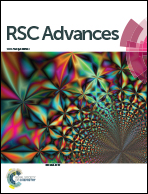Spectroscopic and electrochemical studies on the evaluation of the radical scavenging activities of luteolin by chelating iron†
Abstract
Luteolin, 5,7,3′,4′-tetrahydroxylflavone, which is one of the most common dietary flavonoids, exists in many types of plants including fruits, vegetables and medicinal herbs. Spectroscopic studies (UV-visible, ESI-MS) and cyclic voltammetry (CV) were employed to study the relevant interaction of luteolin and Fe(III) in ethanol, as well as to evaluate the antioxidant activities of luteolin and its complexes against free radical-mediated damage, such as hydroxyl radicals (˙OH) and 1,1-diphenyl-2-picrylhydrazyl (DPPH) radicals. Luteolin can form a luteolin–Fe(III) complex with the ratio of 1 : 1 and coordinate to the Fe(III) ion at the 3′,4′-dihydroxyl group in ring B in the luteolin molecule. Luteolin strongly inhibits Fenton reaction via a combined effect of Fe(II) chelation and radical scavenging activities. The antioxidant activities of luteolin and its Fe(III) complex were evaluated by using the DPPH radical scavenging method. Luteolin shows better antioxidant activity than the luteolin–Fe(III) complex, which is also verified from the electrochemical point of view. The experimental results can be rationalized in terms of structural features governing antioxidant behavior i.e. substitution pattern of ring B in the luteolin molecule.


 Please wait while we load your content...
Please wait while we load your content...